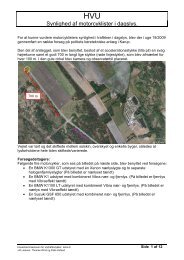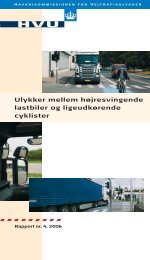Ulykker på motorveje - HVU
Ulykker på motorveje - HVU
Ulykker på motorveje - HVU
You also want an ePaper? Increase the reach of your titles
YUMPU automatically turns print PDFs into web optimized ePapers that Google loves.
9. ENGLISH SUMMARY<br />
The number of motorway accidents and personal injuries has increased in<br />
the last ten years. A decision has also been made to raise the speed limit on<br />
some motorway sections. The Danish Accident Investigation Board has carried<br />
out an in-depth analysis of motorway accidents, to provide recommendations<br />
for accident prevention measures and for measures that should be introduced<br />
for the new speed limits.<br />
A total of 39 motorway accidents were analysed. 112 individuals were involved<br />
in these accidents as driver, passenger or pedestrian. 47 drivers were male,<br />
13 were female and one driver was of unknown sex (the driver fled from the<br />
site). Drivers’ ages were between 17 and 76. 16 of those involved in the<br />
accidents studied were killed, 61 were injured and 35 were uninjured.<br />
These accidents can be considered to be very typical motorway accidents, of<br />
recent years. The depth and detailed nature of the analysis has given valuable<br />
results. However, the number of accidents studied is limited, which means the<br />
statistical value of the results is however low.<br />
The Danish Accident Investigation Board’s analytical approach is based on the<br />
interplay between road user, road, environment and the vehicle immediately<br />
in front, before, during and after an accident. This method gives a more<br />
accurate picture of the circumstances around an accident, and the factors<br />
that determine how serious an accident becomes. The analysis leads to the<br />
identification of a series of accident factors, which through their combination<br />
result in the occurrence of an accident, and a number of injury factors, which<br />
contribute to the seriousness of an accident.<br />
Results and recommendations<br />
Risk blindness<br />
Nearly half of the drivers involved in the accidents studied can be considered<br />
to be risk blind. These drivers’ actions contributed to the accident occurring.<br />
However, they are not aware that they have acted in an irresponsible or<br />
reckless way before, during or after the accident. Risk blindness is considered<br />
to be a factor that interacts with several of the other accident factors revealed<br />
by the analysis.<br />
Poor evaluation of the weather situation<br />
Most drivers who were responsible for accidents, had incorrectly evaluated the<br />
road traffic situation. In half of the accidents where incorrect evaluation was<br />
an accident factor, it was visibility and weather conditions which had been<br />
incorrectly evaluated. Drivers appear to find it difficult to correctly evaluate<br />
visibility and weather conditions such as fog, slippery roads and darkness.<br />
This is shown in the choice of incorrect speeds in relation to weather and<br />
visibility. Drivers are in many cases risk blind, shown in statements made after<br />
an accident indicating that they believed that they had chosen the correct<br />
speed in relation to visibility and weather conditions.<br />
Temarapport • ULYKKER PÅ MOTORVEJE<br />
55





